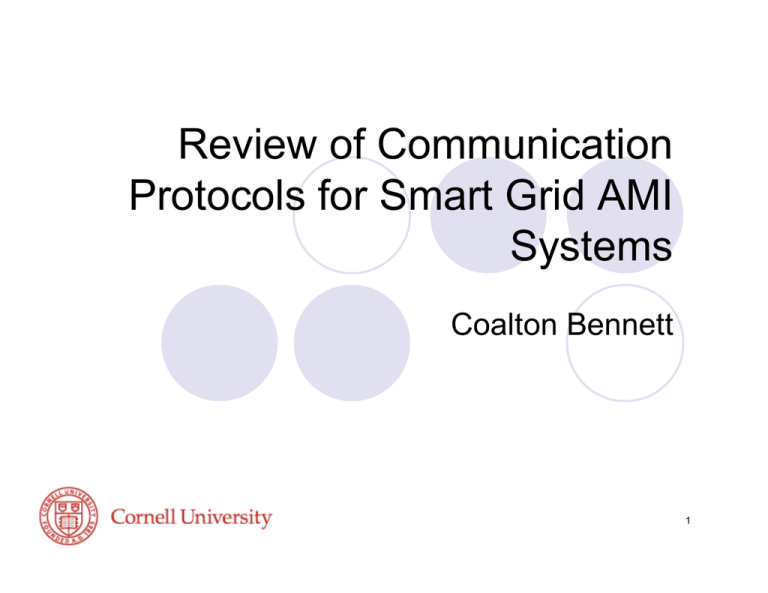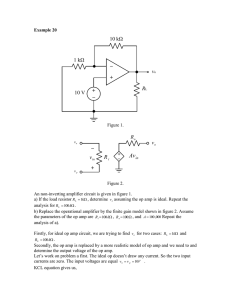Review of Communication Protocols for Smart Grid AMI Systems Coalton Bennett
advertisement

Review of Communication Protocols for Smart Grid AMI Systems Coalton Bennett 1 Outline I. II. III. IV. V. VI. Introduction Motivation C12.22 & C12.19 Overview Potential Routing Protocols Use Case(s) Conclusion 2 I. Introduction What is the Smart Grid? A “Smart grid system” is any two-way communications system and associated equipment and software, including equipment installed on the electrical delivery system and on the premises of retail end-use customers, that utilizes the electrical delivery system to provide real-time monitoring, diagnostic, and control information… California Senate Bill No. 1438 Introduced by Senator Padilla on February 21st, 2008 3 I. Introduction cont’d 4 II. Motivation Create a standard communication protocol independent of Layers 1-6 Allow utilities to use meters from different vendors Allow customers to use different smart appliances from different vendors 5 III. C12.22 & C12.19 Protocol Overview C12.22 is an application layer protocol (e.g. http) Data retrieval consists of six steps: Identification Service Request Logon Service Request Resolve Service Request Security Service Request Read/Write Service Request Logoff/Terminate Service Request 6 III. C12.22 & C12.19 Protocol Overview cont’d Identification Service Request This service is used to obtain information about C12.19 Device functionality. The service returns a code identifying the reference standard, the version and revision of the reference standard implemented, and an optional feature list. Logon Service Request Logon Service establishes a session without establishing access permissions. It provides for immediate transfer to the session state from the idle state. A peer-to-peer association shall be established. 7 III. C12.22 & C12.19 Protocol Overview cont’d Resolve Request The Resolve Service is used to retrieve the native network address of a C12.22 Node. This native address is used to communicate directly with other C12.22 Nodes on the local area network. The Resolve request contains the ApTitle of the C12.22 Node for which native address is requested. Read/Write Service The Read Service is used to cause a transfer of Table data to the requesting device. 8 III. C12.22 & C12.19 Protocol Overview cont’d Logoff Service Request The Logoff Service provides for an orderly termination of the session that was established by the Logon Service. It provides for immediate transfer to the idle state from the session state. The peer-to-peer association shall terminate and all previously negotiated settings shall reset to their default idle-state values. 9 III. C12.19 Table Decade Number Name Number of Tables 0 Configuration Tables 9 1 Data Source Tables 8 2 Register Tables 9 3 Local Display Tables 5 4 Security Tables 6 5 Time-of-Use Tables 7 6 Load Profile Tables 8 7 History and Event Logs 10 10 III. C12.19 Table cont’d 8 User Defined Tables 10 9 Telephone Control Tables 9 10 Extended Source Tables 4 11 Load Control and Pricing Tables 9 12 Network Control Tables 8 13 Relay Control Tables 7 14 Extended User Defined Tables 4 15 Quality of Service 9 16 One Way Devices 5 11 IV. Potential Routing Protocols Bluetooth SIG with 802.11 WiFi with 802.11 Z-Wave with 802.15 6loWPAN with 802.15 Zigbee with 802.15 12 Zigbee 13 IV. Zigbee Routing Protocol For resource constrained networks (battery operated) AODV and Cluster Tree routing is used For non resource constrained networks AODV is used AMI Smart Meter Network 14 IV. AODV 15 IV. MPLS Packets traversing a connectionless network, usually make use of a network layer protocol whereby the individual routers make independent forwarding decisions for that packet. Packet headers contain considerably more information than is needed simply to choose the next hop. Choosing the next hop can therefore be thought of as the composition of two functions. Partitioning the entire set of possible packets into a set of "Forwarding Equivalence Classes (FECs)". Mapping each FEC to a next hop. Insofar as the forwarding decision is concerned, different packets which get mapped into the same FEC are indistinguishable. All packets which belong to a particular FEC and which travel from a particular node will follow the same path. 16 IV. MPLS In MPLS, the assignment of a particular packet to a particular FEC is done just once, as the packet enters the network. The FEC to which the packet is assigned is encoded as a short fixed length value known as a "label". When a packet is forwarded to its next hop, the label is sent along with it. At subsequent hops, there is no further analysis of the packet's network layer header. Rather, the label is used as an index into a table which specifies the next hop, and a new label. The old label is replaced with the new label, and the packet is forwarded to its next hop. In the MPLS forwarding paradigm, once a packet is assigned to a FEC, no further header analysis is done by subsequent routers; all forwarding is driven by the labels. This has a number of advantages over conventional network layer forwarding. 17 IV. AODV vs MPLS 18 VI. Conclusion Reduce our dependency on fossil fuels that have adverse effects on our environment (Global Warming) Reliability of the electric system Reduce costs associated with generation, transmission, and distribution Create efficient markets Reducing suppliers and customers risk in the market 19 Questions? 20



